Khamovniki District
55°43′34″N37°34′16″E/ 55.72611°N 37.57111°E

Khamovniki District(Russian:Хамо́вники) is adistrictofCentral Administrative Okrugof thefederal cityofMoscow,Russia.Population:102,730 (2010 Russian census);[1]97,110 (2002 Census).[2]
The district extends fromBolshoy Kamenny Bridgeinto theLuzhnikibend ofMoskva River;northern boundary withArbat Districtfollows Znamenka Street, Gogolevsky Boulevard, Sivtsev Vrazhek andBorodinsky Bridge.
The district containsPushkin Museum,Cathedral of Christ the Saviour,Devichye Polemedical campus,Novodevichy Conventand memorial cemetery,Luzhniki Stadium.The stretch of Khamovniki betweenBoulevard RingandGarden Ring,known asGolden Mile,is downtown Moscow's most expensive housing area.
From Kremlin to Luzhniki
[edit]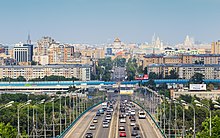
Within the Boulevards: Volkhonka Street
[edit]
The central part of Khamovniki is dominated by the Cathedral of Christ the Savior, a 2000s replica of a 19th-century cathedral byKonstantin Thon,destroyed in 1931.
The history of Volkhonka and Znamenka street goes back to the 14th-century court ofSophia of Lithuania,wife of PrinceVasili Iand the regent of Moscow after his death, which stood on the site ofPashkov House(Russian State Library) and later housed theShuyskyfamily.[3]The site of Pushkin Museum was occupied by the royal Coach Yard (Колымажный двор, Kolymazhny Dvor), giving name to existing Kolymazhny Lane. The western boundary of central district, marked by extinctChertoryibrook on site of present-dayGogol Boulevard,was fortified in 1504 and 1580s. It is believed thatMalyuta Skuratov,close associate ofIvan Grozny,lived and was buried here, as indicated by the tombstone found in the 1930s. The area gained importance with the completion ofBolshoy Kamenny Bridgein the 1690s. Throughout the 18th century, it acquired noble residents likeGolitsyn,DolgorukovandVolkonskyfamilies. A state-run pub on Volkonsky property gave name to Volkhonka Street. Most of historical Volkhonka was demolished in 1838 and the 1880s, clearing sites for Christ the Saviour and a riding school,[4]the latter replaced in 1912 by Pushkin Museum. Znamenka Street was razed in the 20th century and is now occupied by institutions of the Ministry of Defense.
Boulevards to Garden Ring: The Golden Mile
[edit]
Urbanization of the territories beyond the walls ofBely Gorod(Boulevard Ring) is credited to Ivan Grozny. Ivan allocated these lands toOprichnina,his own private domain. Very soon, Ivan's faithful associates resettled intooprichninalands, thus present-day Ostozhenka, Prechistenka and Sivtsev Vrazhek streets initially developed as upper-class neighborhoods and retained this status ever since.[5]Lanes in these neighborhoods (Mansurovsky, Khrushyovsky etc.) are named after original landlords. Ivan's son, childlessFyodor I,instituted extantConception Monasterybetween Ostozhenka andMoskva Riveron the site of old Saint Alexis convent that perished in theFire of Moscow (1547).Until the 1830s, frequent floods discouraged construction near the river, and the boundary of inhabited territories was 100–200 meters to the north from present-day embankment (seeVodootvodny Canalfor more details). Legacy of 16th century survives in historical red and white chambers across Christ the Saviour, restored to their (perceived) original shape.
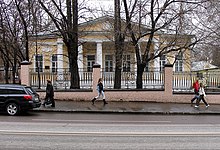
Upper-class population grew stronger after theFire of Moscow (1812),when the main streets were rebuilt inNeoclassical architectureby disciples ofMatvey Kazakov.Grand 2–3 mansions were more common in Prechistenka, smaller single-story buildings—in Ostozhenka Street; some of them survive to date. However, the territory between facades of Ostozhenka and the embankment were a maze of wooden huts, small factories etc.; this disparity continued until the 1990s, and even today there are many run-down, condemned wooden houses.[citation needed]
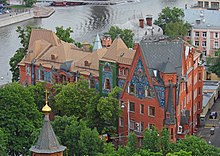
The end of 19th century gradually replaced country-style houses with 3–4 story rental buildings. Architectural diversity expanded intoArt Nouveau(Lev Kekushev's andWilliam Walcot's mansions, 1900–1903),Russian Revivalfantasies (Pertsova Building, 1906–1910,[6]and Tsvetkov House, 1901[7]), Dutch style (Prechistenskaya, 3) and Neoclassical Revival (Mindovsky House byNikita Lazarev).
Since the 1990s, territory of old Ostozhenka became a construction site. Old blocks are torn down one by one and replaced with modern-looking midrise apartment buildings and offices. The area is now probably the most expensive real estate in Moscow, nicknamedThe Golden Mile.In March 2007, advertisedstartingprices for yet unbuilt properties range from 12,000 to 20,000USDper square meter (1,100–2,050 USD per square foot).[8]
Beyond Garden Ring: Khamovniki proper
[edit]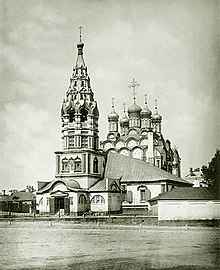
Khamovniki proper is the territory directly beyond Ostozhenka Street (across the Garden Ring).Khamwas the name of fabric made by the craftsmen of localsloboda.These craftsmen, originally fromTver,were forced to settle in Moscow in 1624.[9]ExtantChurch of St. Nicholas in Khamovniki,the center of sloboda, was erected in 1679. In 1708,Peter Iadded a canvas factory. The textile tradition continued into industrial age; late 19th century textile mills are now converted to offices.
The area is marked by two large historical military institutions: the Grain Warehouses (Провиантские склады, 1827[10]) and Khamovniki Barracks, built in 1807–1809 byMatvey Kazakovon the site of canvas factory, and later expanded. A huge parade ground in front of the barracks now forms part ofKomsomolsky Prospekt.The neighborhood also hasLeo Tolstoymemorial house (Lva Tostogo Street, 21).Stalinistapartment blocks between Komsomolsky Prospect and Moskva River belong to some of the most expensive real estate in Moscow.
Novodevichy Convent, cemetery and Devichye Pole
[edit]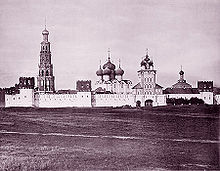
For more details on this section, seeNovodevichy Convent,Novodevichy CemeteryandDevichye Pole
FortifiedNovodevichy Convent,a UNESCOWorld Heritage Site,was established in the early 16th century at the far end of Luzhniki bend to control the river crossing of the oldSmolenskroad. Extant structures remain virtually unchanged since the 17th century. AdjacentNovodevichy Cemetery,inaugurated in 1898, has been Moscow's most famous burial site (excludingKremlin Wall Necropolis).

The area between Khamovniki sloboda and the Convent, once a 1.6 kilometer long stretch of green field used for public festivities, is known asDevichye Pole.In 1884–1897, it was developed in a medical campus ofMoscow State University.State-funded clinics, built in strict neoclassical manner, were lined on the northern side of Bolshaya Pirogovskaya Street; privately funded clinics, on the southern side, present a diversity of styles fromPalladian architecturetoRussian Revivalfantasies. In 1905–1914, the city and private sponsors added new educational properties, including nation's largest college for women. At the same time, Moskva River bank north from the campus developed into a strip of factories; more factories and workers followed during 1915 evacuation of industry and workers fromRiga.To accommodate these residents, in the 1920s theBolshevikadministration built theRationalistUsachevka housing project andConstructivistKauchuk Factory Club.
Luzhniki
[edit]Luzhniki area today is locked between River Moskva and the Moscow Ring Railroad, built in the 20th century. The name is borrowed from an old Luzhniki village, razed to construct the main Stadium.
Urbanization of Luzhniki actually started duringWorld War I.In 1914–1916,Nikolay Vtorovcompany built a munitions factory, still existing on a triangular lot south-east from present-dayLuzhniki Metro Bridge.[11]In 1928, the city built the first wooden Luzhniki Stadium (Chemists' Stadium,15,000 seats) on the site of present-day main arena. This stadium and Luzhniki village was torn down in the 1950s.[12]The opening of the 1980 Olympic Games was held at Luzhniki Stadium.
Notable buildings, cultural and educational facilities
[edit]Museums
[edit]- Pushkin Museumof fine arts, Volkhonka, 12
- Alexander PushkinMuseum, Prechistenka, 12/2
- Leo TolstoyMuseum, Prechistenka, 11
- Leo TolstoyEstate in Khamovniki, Lva Tolstogo, 21
- Red Chambers (Ostozhenka, 2) and White Chambers (Prechistenka, 1) at Prechistenskye Gates
Churches
[edit]- Novodevichy Convent(est. 1582)
- Cathedral of Christ the Saviour(2000)
- Church of St. Nicholas in Khamovniki(1682)www.pravoslavie.ru
- Zachatyevsky Women's Convent (est.1360) Second Zachatyevsky Lanewww.pravoslavie.ru
- Church ofArchangel Michaelof Devichye Pole clinics (1894–1897, architect M.I. Nikiforov),www.pravoslavie.ru

- Church of the Protection of the Holy Virgin on Ostozhenka,Turchaninov Lane, 4
- Church of SaintAntipas of Pergamum,Kolymazhny Lane, 8www.pravoslavie.ru
- Church ofProphet Elijah(1702, architectIvan Zarudny), Second Obydensky Lane, 6www.pravoslavie.ru
- Church ofSaint Vlasy,Gagarinsky Lane, 20www.pravoslavie.ru
- Church of Dormition, Bolshoy Vlasyevsky Lane, 2/2www.pravoslavie.ru
- Church of Raising Lord's Cross in Chisty Vrazhek (1658) First Truzhenikov Lane, 8www.pravoslavie.ru
- Church of Dmitry Prilutsky (1880), Bolshaya Pirogovskaya Street, 6www.pravoslavie.ru[13]
Public transportation access
[edit]- Kropotkinskaya– Pushkin Museum, Christ the Savior
- Smolenskaya (Arbatsko-Pokrovskaya),Smolenskaya (Filyovskaya)– Smolensk Square, Arbat lanes
- Park Kultury-Radialnaya,Park Kultury-Koltsevaya– Khamovniki proper
- Frunzenskaya– Devichye Pole campus
- Sportivnaya–Novodevichy Convent,Luzhniki north
- Vorobyovy Gory– Luzhniki south
References
[edit]- ^Russian Federal State Statistics Service (2011).Всероссийская перепись населения 2010 года. Том 1[2010 All-Russian Population Census, vol. 1].Всероссийская перепись населения 2010 года [2010 All-Russia Population Census](in Russian).Federal State Statistics Service.
- ^Federal State Statistics Service(May 21, 2004).Численность населения России, субъектов Российской Федерации в составе федеральных округов, районов, городских поселений, сельских населённых пунктов – районных центров и сельских населённых пунктов с населением 3 тысячи и более человек[Population of Russia, Its Federal Districts, Federal Subjects, Districts, Urban Localities, Rural Localities—Administrative Centers, and Rural Localities with Population of Over 3,000](XLS).Всероссийская перепись населения 2002 года [All-Russia Population Census of 2002](in Russian).
- ^Russian: П.В. Сытин, "Из истории московских улиц", М, 1948 (Sytin), p.70
- ^Sytin,p.69
- ^Sytin,pp.168, 173
- ^Russian: "Древнерусские мотивы в архитектуре Москвы конца XIX – начала XX века ( “неорусский стиль” ) "," Искусство выбора ", N2, 2003www.mosmodern.race.ruArchivedJune 25, 2007, at theWayback Machine
- ^Russian:moskva.kotoroy.netArchivedDecember 9, 2006, at theWayback Machine
- ^Russian:www.mian.ruArchivedMarch 21, 2007, at theWayback Machine
- ^Sytin,p.267
- ^Sytin,p.160
- ^Russian: "Строители Москвы. Москва начала века" М, ООО О-Мастер, 2001,ISBN5-9207-0001-7(Builders of Moscow)
- ^Russian: Aлександров, Ю.Н., Жуков, К.В., "Силуэты Москвы", М, 1978, c.18
- ^Bolshaya Pirogovskaya Street has an unusually odd numbering; No.6 is actually at its western end, near Novodevichy
External links
[edit]- Copy of official site
- Official site
- Photosandwebcamof Khamovniki
- History of KhamovnikiArchivedJanuary 22, 2013, at theWayback Machine(in Russian)

